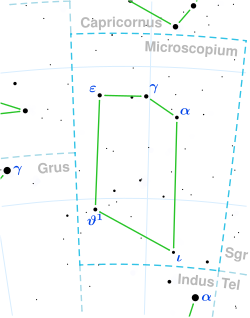
| |
| Observation data Epoch J2000.0 Equinox J2000.0 (ICRS) | |
|---|---|
| Constellation | Microscopium |
| Right ascension | 20 51 58.7618 |
| Declination | −33° 10′ 40.7051″ |
| Apparent magnitude (V) | 6.05±0.01 |
| Characteristics | |
| Spectral type | A1 IV |
| B−V color index | +0.03 |
| Astrometry | |
| Radial velocity (Rv) | −12±4.3 km/s |
| Proper motion (μ) | RA: +7.712 mas/yr Dec.: −5.568 mas/yr |
| Parallax (π) | 6.5022 ± 0.0451 mas |
| Distance | 502 ± 3 ly (154 ± 1 pc) |
| Absolute magnitude (MV) | +0.22 |
| Details | |
| Mass | 2.96 M☉ |
| Radius | 3.5±0.1 R☉ |
| Luminosity | 77.25 L☉ |
| Surface gravity (log g) | 3.58 cgs |
| Temperature | 8,942 K |
| Metallicity | 0.00 dex |
| Rotational velocity (v sin i) | 275±3 km/s |
| Age | 337 Myr |
| Other designations | |
| β Mic, 32 Microscopii[13], CD−33° 15245, HD 198529, HIP 102989, HR 7979, SAO 212499 | |
| Database references | |
| SIMBAD | data |
Beta Microscopii (Beta Mic), Latinized from β Microscopii, is a solitary star in the constellation Microscopium. It is close to the lower limit of stars that are visible to the naked eye having an apparent visual magnitude of 6.05 Based upon an annual parallax shift of 6.5022 mas as seen from Earth, this star is located 502 light years away from the Sun. At that distance, the visual magnitude is diminished by an extinction factor of 0.19 due to interstellar dust.
Beta Mic has a stellar classification of A1 IV, indicating that it is an evolved A-type subgiant. Older sources give it a class of A2 Vn, suggesting that it is an A-type main-sequence star with nebulous absorption lines due to rapid rotation. Consistent with the older classification, the star is spinning rapidly with a projected rotational velocity of 275 km/s. The star has 2.96 times the mass of the Sun and due to its evolved status, has a radius of 3.5 R☉. It radiates at 77.2 times the luminosity of the Sun from its photosphere at an effective temperature of 8,942 K, giving a white hue. Beta Mic has a solar metallicity and is estimated to be around 340 million years old.
References
- ^ Brown, A. G. A.; et al. (Gaia collaboration) (2021). "Gaia Early Data Release 3: Summary of the contents and survey properties". Astronomy & Astrophysics. 649: A1. arXiv:2012.01533. Bibcode:2021A&A...649A...1G. doi:10.1051/0004-6361/202039657. S2CID 227254300. (Erratum: doi:10.1051/0004-6361/202039657e). Gaia EDR3 record for this source at VizieR.
- ^ Høg, E.; Fabricius, C.; Makarov, V. V.; Urban, S.; Corbin, T.; Wycoff, G.; Bastian, U.; Schwekendiek, P.; Wicenec, A. (March 2000). "The Tycho-2 catalogue of the 2.5 million brightest stars". Astronomy and Astrophysics. 355: L27 – L30. Bibcode:2000A&A...355L..27H. ISSN 0004-6361.
- ^ Houk, N. (1982). Michigan Catalogue of Two-dimensional Spectral Types for the HD stars. Volume_3. Declinations -40_ƒ0 to -26_ƒ0. Bibcode:1982mcts.book.....H.
- Corben, P. M.; Stoy, R. H. (1968), "Photoelectric Magnitudes and Colours for Bright Southern Stars", Monthly Notes of the Astronomical Society of Southern Africa, 27: 11, Bibcode:1968MNSSA..27...11C.
- Gontcharov, G. A. (November 2006), "Pulkovo Compilation of Radial Velocities for 35 495 Hipparcos stars in a common system", Astronomy Letters, 32 (11): 759–771, arXiv:1606.08053, Bibcode:2006AstL...32..759G, doi:10.1134/S1063773706110065, S2CID 119231169.
- ^ Anderson, E.; Francis, Ch. (May 2012). "XHIP: An extended hipparcos compilation". Astronomy Letters. 38 (5): 331–346. arXiv:1108.4971. Bibcode:2012AstL...38..331A. doi:10.1134/S1063773712050015. ISSN 1063-7737. S2CID 119257644.
- ^ Kervella, Pierre; Arenou, Frédéric; Thévenin, Frédéric (2022). "Stellar and substellar companions from Gaia EDR3". Astronomy & Astrophysics. 657: A7. arXiv:2109.10912. Bibcode:2022A&A...657A...7K. doi:10.1051/0004-6361/202142146. eISSN 1432-0746. ISSN 0004-6361.
- ^ Stassun, Keivan G.; et al. (9 September 2019). "The Revised TESS Input Catalog and Candidate Target List". The Astronomical Journal. 158 (4): 138. arXiv:1905.10694. Bibcode:2019AJ....158..138S. doi:10.3847/1538-3881/ab3467. ISSN 0004-6256.
- Steinmetz, Matthias; et al. (27 July 2020). "The Sixth Data Release of the Radial Velocity Experiment (Rave). II. Stellar Atmospheric Parameters, Chemical Abundances, and Distances". The Astronomical Journal. 160 (2): 83. arXiv:2002.04512. Bibcode:2020AJ....160...83S. doi:10.3847/1538-3881/ab9ab8. eISSN 1538-3881.
- ^ Anders, F.; et al. (February 2022). "Photo-astrometric distances, extinctions, and astrophysical parameters for Gaia EDR3 stars brighter than G = 18.5". Astronomy & Astrophysics. 658: A91. arXiv:2111.01860. Bibcode:2022A&A...658A..91A. doi:10.1051/0004-6361/202142369. eISSN 1432-0746. ISSN 0004-6361.
- ^ Gontcharov, G. A. (December 2012). "Dependence of kinematics on the age of stars in the solar neighborhood". Astronomy Letters. 38 (12): 771–782. arXiv:1606.08814. Bibcode:2012AstL...38..771G. doi:10.1134/S1063773712120031. ISSN 0320-0108. S2CID 255201789.
- ^ Díaz, C. G.; González, J. F.; Levato, H.; Grosso, M. (July 2011). "Accurate stellar rotational velocities using the Fourier transform of the cross correlation maximum". Astronomy & Astrophysics. 531: A143. arXiv:1012.4858. Bibcode:2011A&A...531A.143D. doi:10.1051/0004-6361/201016386. eISSN 1432-0746. ISSN 0004-6361.
- Gould, Benjamin Apthorp (1878). "Uranometria Argentina : brillantez y posicion de las estrellas fijas, hasta la septima magnitud, comprendidas dentro de cien grados del polo austral : con atlas". Resultados del Observatorio Nacional Argentino. 1. Bibcode:1879RNAO....1.....G.
- "bet Mic". SIMBAD. Centre de données astronomiques de Strasbourg. Retrieved 2017-08-14.
{{cite web}}: CS1 maint: postscript (link) - Evans, D. S. (1966). "Fundamental data for Southern stars (6th list)". Royal Greenwich Observatory Bulletins. 110: 185. Bibcode:1966RGOB..110..185E.
| Constellation of Microscopium | |||||||||||||
|---|---|---|---|---|---|---|---|---|---|---|---|---|---|
| Stars |
| ||||||||||||
| |||||||||||||
| Galaxies |
| ||||||||||||